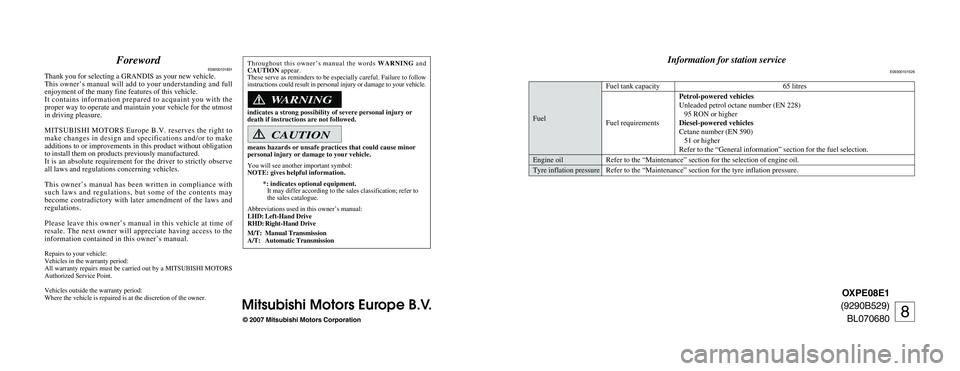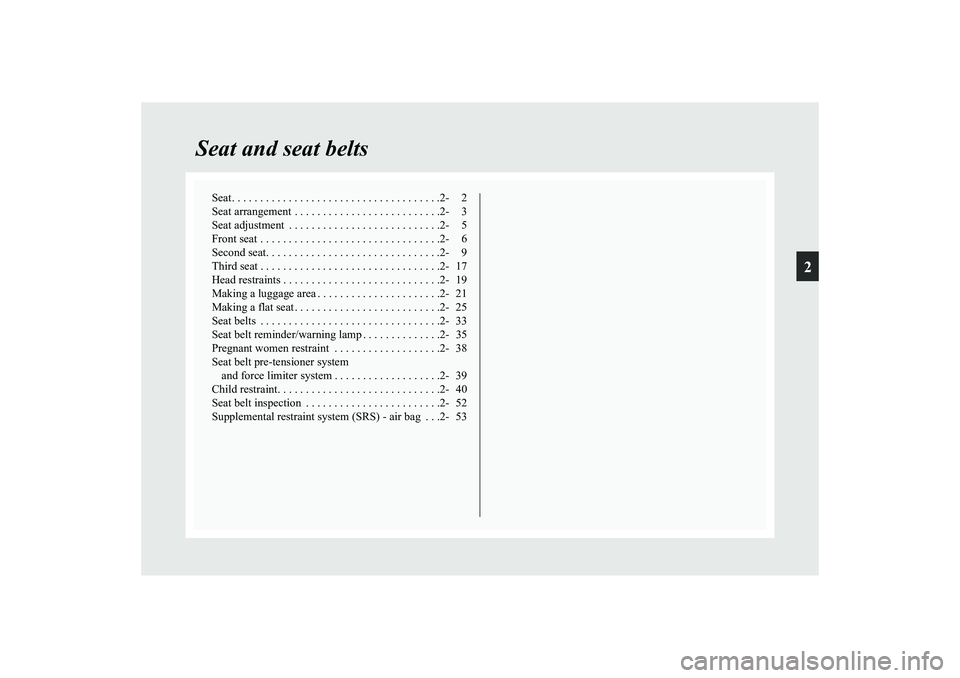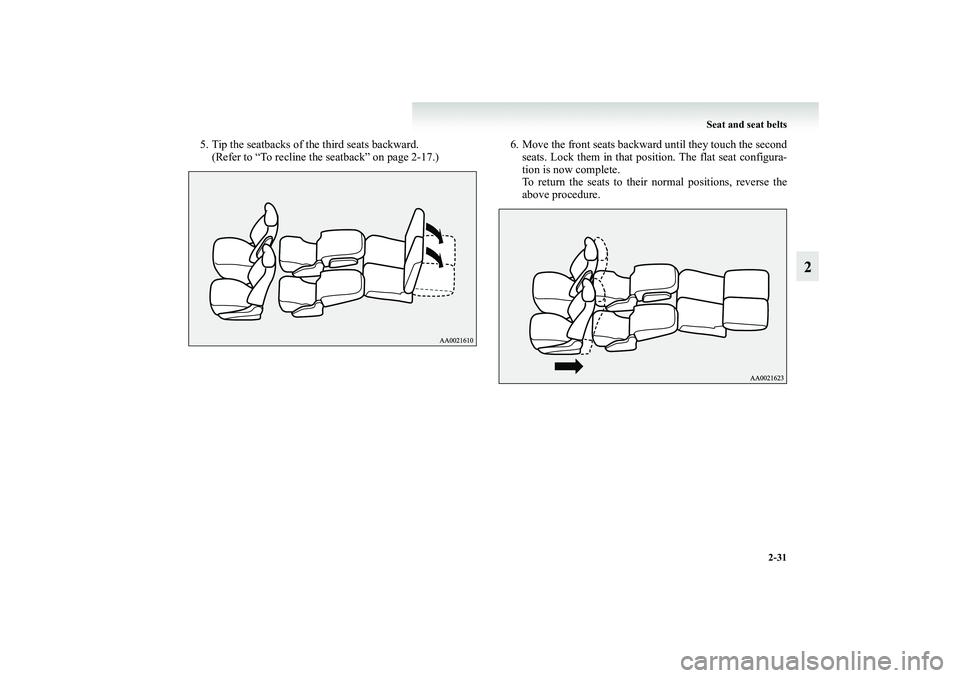flat MITSUBISHI GRANDIS 2008 Owner's Manual (in English)
[x] Cancel search | Manufacturer: MITSUBISHI, Model Year: 2008, Model line: GRANDIS, Model: MITSUBISHI GRANDIS 2008Pages: 458, PDF Size: 18.52 MB
Page 2 of 458

OXPE08E1
(9290B529)
BL070680
© 2007 Mitsubishi Motors Corporation
Mitsubishi Motors Europe B.V.
ForewordE09200101831
Thank you for selecting a GRANDIS as your new vehicle.
This owner’s manual will add to your understanding and full
enjoyment of the many fine features of this vehicle.
It contains information prepared to acquaint you with the
proper way to operate and maintain your vehicle for the utmost
in driving pleasure.
MITSUBISHI MOTORS Europe B.V. reserves the right to
make changes in design and specifications and/or to make
additions to or improvements in this product without obligation
to install them on products previously manufactured.
It is an absolute requirement for the driver to strictly observe
all laws and regulations concerning vehicles.
This owner’s manual has been written in compliance with
such laws and regulations, but some of the contents may
become contradictory with later amendment of the laws and
regulations.
Please leave this owner’s manual in this vehicle at time of
resale. The next owner will appreciate having access to the
information contained in this owner’s manual.
Repairs to your vehicle:
Vehicles in the warranty period:
All warranty repairs must be carried out by a MITSUBISHI MOTORS
Authorized Service Point.
Vehicles outside the warranty period:
Where the vehicle is repaired is at the discretion of the owner.Throughout this owner’s manual the words WARNINGand
CAUTIONappear.
These serve as reminders to be especially careful. Failure to follow
instructions could result in personal injury or damage to your vehicle.
indicates a strong possibility of severe personal injury or
death if instructions are not followed.
means hazards or unsafe practices that could cause minor
personal injury or damage to your vehicle.
You will see another important symbol:
NOTE: gives helpful information.
*: indicates optional equipment.
It may differ according to the sales classification; refer to
the sales catalogue.
Abbreviations used in this owner’s manual:
LHD: Left-Hand Drive
RHD: Right-Hand Drive
M/T: Manual Transmission
A/T: Automatic Transmission
WARNING
CAUTION
Information for station service
E09300101526
Fuel tank capacity 65 litres
Petrol-powered vehicles
Unleaded petrol octane number (EN 228)
Fuel95 RON or higher
Fuel requirementsDiesel-powered vehicles
Cetane number (EN 590)
51 or higher
Refer to the “General information” section for the fuel selection.
Engine oil Refer to the “Maintenance” section for the selection of engine oil.
Tyre inflation pressure Refer to the “Maintenance” section for the tyre inflation pressure.
8
eng270680_XP08_cv 05-07-2007 12:31 Page 2
Page 14 of 458

Overview
Locking and unlocking p. 1-7
Keyless entry system* p. 1-5
Tyre inflation pressures p. 8-21
Changing tyres p. 6-20
Tyre rotation p. 8-24
Tyre chains p. 8-26
Wheel covers* p. 6-26
Rear turn-signal lamps
p. 3-37, 8-44, 8-54
Stop and tail lamps
p. 3-32 Licence plate lamps
p. 3-32, 8-44, 8-55 Tailgate p. 1-11 Rear window wiper and washer p. 3-43
Rear fog lamp (LHD vehicles)
p. 3-40, 8-44, 8-54
Reversing lamp (RHD vehicles)
p. 8-44, 8-54
Back sensors* p. 4-52Corner sensors*
p. 4-52Reversing lamp (LHD vehicles) p. 8-44, 8-54
Rear fog lamp (RHD vehicles) p. 3-40, 8-44, 8-54 High-mounted stop lamp p. 8-44
BK-XP08E1ENUK.en-uk.book Page 11 Monday, August 13, 2007 2:20 PM
Page 35 of 458

Locking and unlocking
1-13
1
To openPull the tailgate handle upward to open the tailgate.NOTE●If you do not open the tailgate immediately after pulling
the handle, the tailgate will automatically be relocked.
If this happens, pull the handle again and lift the tailgate
with the handle still pulled.
●The tailgate cannot be opened when the battery is flat or
disconnected.
To closePull the tailgate grip (A) downward as illustrated and release it
before the tailgate closes completely. Gently slam the tailgate
from the outside so that it is completely closed.
CAUTION
!●Make sure there is no one standing nearby when
opening the tailgate.
BK-XP08E1ENUK.en-uk.book Page 13 Monday, August 13, 2007 2:20 PM
Page 49 of 458

2
Seat and seat belts
Seat. . . . . . . . . . . . . . . . . . . . . . . . . . . . . . . . . . . . .2- 2
Seat arrangement . . . . . . . . . . . . . . . . . . . . . . . . . .2- 3
Seat adjustment . . . . . . . . . . . . . . . . . . . . . . . . . . .2- 5
Front seat . . . . . . . . . . . . . . . . . . . . . . . . . . . . . . . .2- 6
Second seat. . . . . . . . . . . . . . . . . . . . . . . . . . . . . . .2- 9
Third seat . . . . . . . . . . . . . . . . . . . . . . . . . . . . . . . .2- 17
Head restraints . . . . . . . . . . . . . . . . . . . . . . . . . . . .2- 19
Making a luggage area . . . . . . . . . . . . . . . . . . . . . .2- 21
Making a flat seat . . . . . . . . . . . . . . . . . . . . . . . . . .2- 25
Seat belts . . . . . . . . . . . . . . . . . . . . . . . . . . . . . . . .2- 33
Seat belt reminder/warning lamp . . . . . . . . . . . . . .2- 35
Pregnant women restraint . . . . . . . . . . . . . . . . . . .2- 38
Seat belt pre-tensioner system
and force limiter system . . . . . . . . . . . . . . . . . . .2- 39
Child restraint. . . . . . . . . . . . . . . . . . . . . . . . . . . . .2- 40
Seat belt inspection . . . . . . . . . . . . . . . . . . . . . . . .2- 52
Supplemental restraint system (SRS) - air bag . . .2- 53
BK-XP08E1ENUK.en-uk.book Page 1 Monday, August 13, 2007 2:20 PM
Page 51 of 458

Seat and seat belts
2-3
2 Seat arrangement
E00400200430
By operating the seats select the desired seats arrangement.
6-person seat
7-person seat
Normal usageFlat seat
With front and second
seats → p. 2-26With second and third
seats → p. 2-29
BK-XP08E1ENUK.en-uk.book Page 3 Monday, August 13, 2007 2:20 PM
Page 73 of 458

Seat and seat belts
2-25
2 Making a flat seat
E00404300064
By removing the head restraints and fully reclining the seat-
backs of the seats, one large flat seat is achieved.
WARNING
!●Never drive with luggage or passengers on the flat
seat. This is highly dangerous.
In a collision, people or children riding unrestrained
in these areas are more likely to be seriously injured
or killed.
Do not allow people or children to ride in any area of
your vehicle that is not equipped with seats and seat
belts, and make sure that everyone travelling in
your vehicle is in a seat and wearing a seat belt, or in
the case of a child is strapped in a child restraint.
In the interest of their safety, children should not be
allowed to adjust the seats.
CAUTION
!●To make a flat seat, stop the vehicle in a safe place.●Make sure that the seat is adjusted by an adult.
If it is adjusted by a child, an unexpected accident
might occur.●When sliding the seat, be sure not to catch your
hand or leg.●Do not walk around on top of the seats after they
have been laid flat.●To ensure the seats are locked securely, attempt to
move them back and forth.●Do not jump on, or impact the seatbacks heavily.●To raise the seatback, sit on the seat and put a hand
on the seatback and raise slowly. Never have a child
do this operation, or an unexpected accident may
result.
BK-XP08E1ENUK.en-uk.book Page 25 Monday, August 13, 2007 2:20 PM
Page 76 of 458

2-28 Seat and seat belts
2
6. The flat seat configuration is now complete.
To return the seats to the normal position, reverse the
above procedure.
NOTE●The removed head restraints (A) can be fitted together and
stored in the cargo net in the luggage area. (Refer to
“Cargo net” on page 5-78.)
BK-XP08E1ENUK.en-uk.book Page 28 Monday, August 13, 2007 2:20 PM
Page 79 of 458

Seat and seat belts
2-31
2
5. Tip the seatbacks of the third seats backward.
(Refer to “To recline the seatback” on page 2-17.)6. Move the front seats backward until they touch the second
seats. Lock them in that position. The flat seat configura-
tion is now complete.
To return the seats to their normal positions, reverse the
above procedure.
BK-XP08E1ENUK.en-uk.book Page 31 Monday, August 13, 2007 2:20 PM
Page 89 of 458

Seat and seat belts
2-41
2
Caution for installing the child restraint on vehi-
cle with front passenger air bagThe label shown here is attached on vehicles with front passen-
ger air bag.
WARNING
!●Extreme Hazard!
Do not use a rearward facing child restraint on a
seat protected by an air bag in front of it!
WARNING
!●A REARWARD FACING CHILD RESTRAINT
must NOT be used in the front passenger seat if the
front passenger’s air bag has not been deactivated.
The force of an inflating air bag could kill or cause
serious injuries to the child. A rearward facing child
restraint should be used in the rear seat.Front passenger’s air bag ON
BK-XP08E1ENUK.en-uk.book Page 41 Monday, August 13, 2007 2:20 PM
Page 101 of 458

Seat and seat belts
2-53
2 Supplemental restraint system (SRS) -
air bag
E00407201377
The information written in this supplemental restraint system
(SRS) section contains important points concerning the driver,
front passenger, side and curtain air bags.
The SRS driver and front passenger air bags are designed to
supplement the primary protection of the driver and front pas-
senger side seat belt systems by providing those occupants
with protection against head and chest injuries in certain mod-
erate-to-severe frontal collisions.
The SRS driver and front passenger air bags employ a dual
stage air bag system. The SRS driver and front passenger air
bag is controlled by the impact sensors (at the front of the vehi-
cle and near the center of the vehicle at floor level) and the
driver’s seat position sensor. The SRS front passenger air bag
is controlled by the impact sensors.
The SRS side air bags are designed to supplement the seat belts
and provide the driver and front passenger with protection
against chest and abdomen injuries in certain moderate-to-
severe side impact collisions.
The SRS curtain air bags are designed to supplement the seat
belts and provide the driver and passenger with protection
against head injuries in certain moderate-to-severe side impact
collisions.The SRS is NOT a substitute for the seat belts; for maximum
protection in all types of crashes and accidents, seat belts
should ALWAYS be worn by everyone who drives or rides in
this vehicle. (With infants and small children in child restraints
and older children buckled in the rear seat.)
WARNING
!●IT IS VERY IMPORTANT TO ALWAYS PROP-
ERLY WEAR YOUR SEAT BELT, EVEN WITH
AN AIR BAG:
• Seat belts help keep the driver and passenger
properly positioned, which reduces injury risk in
all collisions, and reduces the risk of serious or
fatal injuries when the air bags inflate.
During sudden braking just before a collision, an
unrestrained or improperly restrained driver or
passenger can move forward into direct contact
with or within close proximity to the air bag which
may then deploy during the collision.
The initial stage of air bag inflation is the most
forceful which could cause serious or fatal injuries
if the occupant contacts it at this stage.
• Seat belts reduce the risk of injury in roll-overs,
rear impact collisions, and in lower-speed frontal
collisions, because driver’s and passenger’s air
bags are not designed to inflate in those situations.
• Seat belts reduce the risk of being thrown from
your vehicle in a collision or roll-over.
BK-XP08E1ENUK.en-uk.book Page 53 Monday, August 13, 2007 2:20 PM